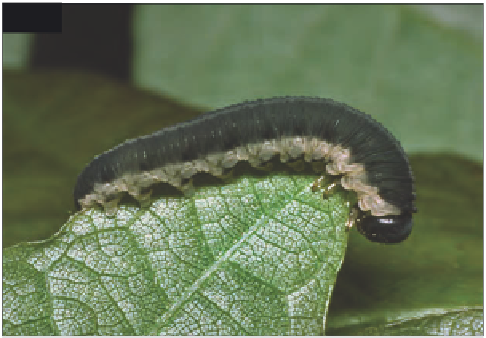Biology Reference
In-Depth Information
952
Apethymus serotinus
(Müller) (
952
)
syn.
A. braccatus
(Gmelin in Linnaeus);
A. tibialis
(Panzer)
This widely distributed but local species is associated
with oak (
Quercus
). Larvae feed on the foliage from
May to July, and commonly rest fully exposed on
the upper surface of expanded leaves. Fully grown
individuals are 15-18 mm long, with a shiny black head
and the much wrinkled body dark grey above and light
grey to yellowish grey at the sides and below. Adults
(8-10 mm long) are mainly black, with the hind tibiae
white basally and the sixth to eighth antennal segments
also usually white. The adults occur from August to
October.
952
Larva of
Apethymus serotinus
.
Ardis brunniventris
(Hartig) (
953-954
)
syn.
A. bipunctata
(Cameron)
Rose shoot sawfly
A locally common and often destructive pest of rose
(
Rosa
). Widely distributed in Europe; also present in
North America.
Blennocampa pusilla
(Klug) (
955-958
)
Leaf-rolling rose sawfly
Generally common on wild and cultivated rose (
Rosa
);
often an important pest in nurseries and gardens. Present
throughout Europe.
DESCRIPTION
Adult:
5.5-6.5 mm long; black, with pronotum, tegulae
and legs partly yellowish white.
Larva:
up to 12 mm
long; brownish white, with a light brown head; legs
poorly developed.
DESCRIPTION
Adult:
3.0-4.5 mm long; mainly black, with whitish
knees, tibiae and tarsi.
Larva:
up to 10 mm long; head
brown; body light green, with short, spiny hairs on
the back.
LIFE HISTORY
Adults occur from May onwards, the period of
emergence being very protracted (often giving the
impression of two generations) and also varying
considerably from year to year. Eggs are laid in leaf
tissue on the young terminal buds, and hatch a few days
later. Each young larva feeds briefly on the leaf tissue
but soon bores into the shoot tip, typically one per
infested shoot. Feeding continues within the shoot for
about three weeks, the larva burrowing downwards for
a few centimetres and expelling considerable quantities
of wet, black frass through the original entry hole. When
fully grown the larva vacates the shoot and drops to the
ground, leaving behind a characteristic exit hole at the
base of the feeding gallery. Larvae overwinter in earthen
cells and pupate in the spring.
LIFE HISTORY
Adults are active during May and June, females
depositing eggs singly in the underside of rose leaves
(leaflets), close to the leaf margin. Females also use
their ovipositor to probe the tissue on either side of the
midrib; this causes the leaf blade to roll tightly inwards
to form a protective tube in which the larva eventually
feeds; leaves in which eggs have not been laid also
become rolled if they have been probed by the female.
The larvae feed from late May or June to July or
August. They then enter the soil to overwinter in
cocoons. Pupation occurs in the spring. There is just
one generation annually.
DAMAGE
The presence of rolled, drooping leaves spoils the
appearance of bushes and the quality of nursery stock;
severe attacks also reduce plant vigour. Certain
cultivars, including various climbing roses, are attacked
more frequently than others. Infestations are uncommon
on standard-grown bushes.
DAMAGE
Infested shoot tips wilt and die, affected tissue turning
black. Growth of young bushes is greatly affected, and
loss of terminal shoots results in the development of
lateral shoots. Damage is most severe on nursery
rootstock.

Search WWH ::

Custom Search